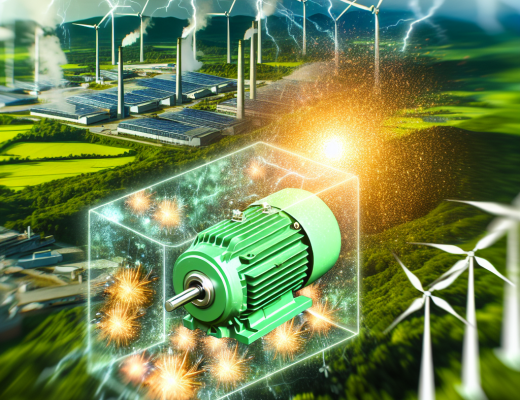You have likely heard of power generation, but have you ever considered cogeneration as a way to maximize efficiency in this process? This innovative approach allows you to generate electricity while simultaneously capturing and utilizing waste heat, significantly boosting overall energy efficiency. In this post, we will research into how cogeneration systems work and how they can benefit both your wallet and the environment.
The Basics of Cogeneration
What is Cogeneration?
While you may have heard of traditional power generation methods such as using coal or natural gas to produce electricity, cogeneration offers a more efficient alternative. Cogeneration, also known as combined heat and power (CHP), is a process where electricity and useful thermal energy are generated simultaneously. This means that instead of just producing electricity in isolation, cogeneration systems make the most out of the fuel source by also capturing and utilizing the heat that is typically wasted in conventional power plants.
How Does Cogeneration Work?
An efficient way to think of cogeneration is as a two-for-one deal. One of the main components in a cogeneration system is a prime mover, such as a gas turbine, steam turbine, or engine, which generates electricity. The waste heat produced during this electricity generation process is then captured and utilized for applications such as heating water, space heating, or in industrial processes. This dual-purpose approach is what sets cogeneration apart from conventional power generation methods.
Doesn’t it sound amazing to not only produce electricity but also make use of what would have otherwise been wasted heat? This is the beauty of cogeneration – maximizing efficiency by making the most out of every bit of energy produced.
Benefits of Cogeneration
Increased Energy Efficiency
Any time you can produce two forms of energy from one fuel source, you are maximizing efficiency. This is the beauty of cogeneration. By capturing and utilizing the heat that is normally wasted in traditional power generation processes, you can dramatically increase your overall energy efficiency.
Reduced Greenhouse Gas Emissions
One of the significant benefits of cogeneration is the reduction in greenhouse gas emissions compared to conventional power generation methods. By using the waste heat to produce additional energy, cogeneration helps to lower the carbon footprint of your facility.
To further illustrate, cogeneration plants typically produce up to 40% less greenhouse gas emissions than traditional power plants. This reduction is crucial in combating climate change and creating a more sustainable future.
Cost Savings
A key advantage of cogeneration is the cost savings it offers. By generating electricity and heat simultaneously, you are able to reduce your energy costs and increase the overall financial viability of your operations.
Cost-effective energy solutions are vital for businesses looking to remain competitive in today’s market. Cogeneration not only helps you save money on energy expenses but also improves your bottom line in the long run.
Types of Cogeneration Systems
Despite the various technologies available for cogeneration systems, they can generally be categorized into reciprocating engines, gas turbines, steam turbines, and fuel cells. Each type offers unique advantages and efficiency levels, allowing you to choose the most suitable option based on your specific energy needs.
- Reciprocating Engines: Cogeneration systems utilizing reciprocating engines are known for their flexibility and reliability. These engines can run on a variety of fuels, including natural gas, diesel, and biogas. The waste heat produced during power generation can be harnessed for heating purposes, maximizing overall efficiency and cost savings.
Gas Turbines
On the other hand, gas turbines are widely used in large-scale cogeneration plants due to their high efficiency and low emissions. These systems burn natural gas to produce electricity and utilize the exhaust heat to generate steam for additional power generation. Gas turbines are ideal for applications requiring high power output and quick start-up times.
With continuous advancements in technology, modern gas turbine cogeneration systems offer increased efficiency and reduced environmental impact. These systems can be integrated seamlessly into existing power plants or used as standalone units to meet varying energy demands.
Steam Turbines
On the other hand, steam turbines have been a staple in the power generation industry for decades. These systems utilize high-pressure steam to drive turbine generators and produce electricity efficiently. Steam turbines are well-suited for industrial applications that require constant power output and process steam.
Fuel Cells
Types of cogeneration systems also include fuel cells, which use electrochemical reactions to convert fuel into electricity and heat. Fuel cells are highly efficient and can run on various fuels, including natural gas, hydrogen, and biogas. These systems are compact, quiet, and have low emissions, making them an ideal choice for both residential and commercial applications.
To further optimize efficiency, fuel cell cogeneration systems can be combined with other technologies, such as solar panels or battery storage, to create a comprehensive energy solution. By integrating different power sources, you can maximize energy savings and reduce your carbon footprint.
Understanding the different types of cogeneration systems available allows you to make informed decisions when selecting the most suitable option for your energy needs. Whether you prioritize efficiency, cost savings, or environmental sustainability, there is a cogeneration system that can meet your specific requirements.
Applications of Cogeneration
Industrial Processes
To maximize efficiency in power generation, cogeneration plays a crucial role in various industrial processes. The use of cogeneration systems in industries such as manufacturing, chemical production, and oil refining helps to optimize energy usage by simultaneously producing electricity and capturing waste heat for other operations. By utilizing this waste heat, you can significantly reduce energy costs and greenhouse gas emissions.
Commercial Buildings
Industrial and commercial buildings can benefit from cogeneration by generating electricity on-site and using the waste heat for space heating and cooling, as well as hot water production. This integrated approach not only increases energy efficiency but also enhances the overall resilience of the building’s energy system. You can achieve cost savings and reduce reliance on the grid by implementing cogeneration systems in commercial buildings.
Commercial buildings, such as office complexes, shopping malls, and hotels, can significantly benefit from cogeneration systems. By installing such systems, you not only save on energy costs but also reduce environmental impact by lowering carbon emissions.
Institutional Facilities
Commercial and institutional facilities like hospitals, universities, and government buildings can enhance their energy efficiency with cogeneration systems. By adopting this technology, you can ensure a reliable power supply during outages and peak demand periods, while also meeting sustainability goals. Cogeneration in institutional facilities offers you the opportunity to optimize energy use and reduce operational costs.
Commercial and institutional facilities can benefit from cogeneration systems by improving energy efficiency, reducing operational costs, and enhancing sustainability efforts. By incorporating cogeneration into energy planning, you can achieve a more resilient and environmentally friendly energy supply.
Residential Areas
Cogeneration can also be leveraged in residential areas to maximize energy efficiency and cost savings. By implementing cogeneration systems in apartment buildings or housing developments, you can generate electricity locally and utilize waste heat for heating and hot water, reducing your dependency on traditional grid systems.
With cogeneration systems in residential areas, you can not only save on energy costs but also contribute to a more sustainable and efficient power generation system overall.
Design and Installation Considerations
System Sizing and Configuration
All cogeneration systems need to be properly sized and configured to maximize efficiency. Sizing your system involves determining the appropriate capacity based on your energy needs and usage patterns. Factors such as the size of your facility, the types of equipment used, and the amount of heat and power required will all influence the sizing process. The configuration of the system, including the number and type of generators, heat exchangers, and storage tanks, is also crucial in ensuring optimal performance.
Heat Recovery and Storage
An imperative component of cogeneration systems is the ability to recover waste heat generated during the power generation process. This recovered heat can be stored for later use, increasing overall efficiency and reducing energy costs. With proper heat recovery and storage solutions in place, you can ensure that no energy goes to waste and that your system operates at its full potential.
Electrical Interconnection and Grid Stability
Sizing the electrical interconnection of your cogeneration system is critical to ensuring smooth operation and grid stability. By properly sizing the connection to the grid, you can avoid overloading the system and causing disruptions. It is important to consider factors such as peak energy usage times and grid requirements when designing the electrical interconnection.
Operational and Maintenance Challenges
Not only does cogeneration offer numerous benefits in terms of efficiency and cost-effectiveness, but it also comes with its own set of operational and maintenance challenges that need to be addressed to ensure optimal performance.
Performance Monitoring and Optimization
Performance monitoring and optimization play a critical role in maximizing the efficiency of your cogeneration system. By regularly monitoring key performance indicators such as fuel consumption, heat rate, and electricity generation, you can identify areas for improvement and fine-tune your system for optimal performance.
Maintenance Strategies and Scheduling
Maintenance strategies and scheduling are necessary components of ensuring the longevity and reliability of your cogeneration system. By implementing a proactive maintenance approach that includes regular inspections, preventive maintenance tasks, and timely repairs, you can avoid costly downtime and unexpected breakdowns.
For instance, scheduling routine maintenance during planned shutdown periods can help minimize disruptions to your operations and extend the lifespan of your equipment.
Troubleshooting and Repair
An effective troubleshooting and repair process is crucial for addressing issues promptly and minimizing downtime. By having a well-trained maintenance team in place and a comprehensive inventory of spare parts, you can quickly troubleshoot any issues that arise and carry out repairs efficiently.
Maintenance staff should be trained to identify common problems such as leaks, blockages, or equipment malfunctions and equipped with the necessary tools and resources to address these issues in a timely manner.
Be mindful of, proactive maintenance and regular monitoring are key to maximizing the efficiency and reliability of your cogeneration system.
Future of Cogeneration
Unlike traditional power generation methods, cogeneration offers a more efficient way of producing electricity and heat simultaneously. As technology continues to advance, the future of cogeneration looks promising with the emergence of new trends and technologies, developments in policies and regulations, and a positive global market outlook.
Emerging Trends and Technologies
Emerging trends and technologies in cogeneration are focused on increasing overall efficiency and reducing environmental impact. Advancements in combined heat and power (CHP) systems, such as integrating renewable energy sources like solar and biomass, are gaining traction. Additionally, the implementation of smart grid technology and energy storage solutions is improving the flexibility and reliability of cogeneration systems.
Policy and Regulatory Developments
Developments in policies and regulations play a crucial role in shaping the future of cogeneration. Governments around the world are recognizing the importance of promoting energy efficiency and reducing greenhouse gas emissions. Incentive programs, carbon pricing mechanisms, and supportive regulations are being established to encourage the adoption of cogeneration technologies.
This favorable policy environment is creating a conducive atmosphere for investments in cogeneration projects, driving innovation and growth in the sector. By aligning regulatory frameworks with sustainability goals, countries are paving the way for a more sustainable energy future.
Global Market Outlook
Emerging as a key player in the global energy landscape, cogeneration is projected to experience significant growth in the coming years. The increasing demand for reliable and efficient power generation solutions, coupled with the focus on reducing carbon emissions, is driving the adoption of cogeneration technologies worldwide.
Global initiatives such as the Paris Agreement and the Sustainable Development Goals are further bolstering the market for cogeneration by emphasizing the importance of clean energy production. As more countries shift towards sustainable energy systems, cogeneration is poised to play a vital role in meeting the growing energy needs while mitigating the impact on the environment.
Final Words
On the whole, cogeneration is a smart and efficient solution for maximizing energy production. By simultaneously generating electricity and capturing waste heat for other uses, cogeneration systems can significantly increase overall energy efficiency. This innovative approach not only reduces energy costs but also helps decrease greenhouse gas emissions, making it a sustainable option for power generation. By considering cogeneration for your energy needs, you can make a positive impact on the environment while also benefiting from greater energy efficiency.





